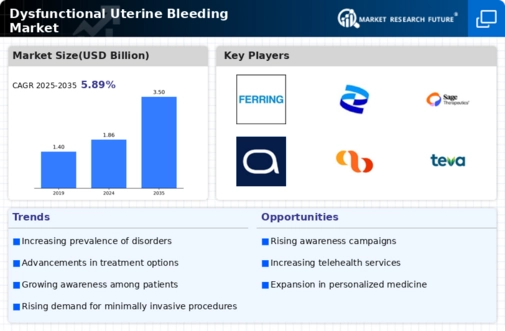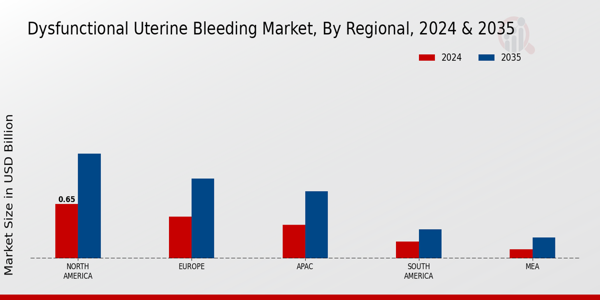Market Growth Projections
The Global Dysfunctional Uterine Bleeding Market Industry is projected to experience robust growth over the coming years. With a market value anticipated to reach 1.86 USD Billion in 2024 and further expand to 3.5 USD Billion by 2035, the industry is on a promising trajectory. The compound annual growth rate of 5.92% from 2025 to 2035 indicates a strong demand for effective treatment options and increased healthcare investments. This growth is likely to be driven by various factors, including advancements in medical technology, rising awareness of women's health issues, and an aging population.
Growing Geriatric Population
The aging population is a significant driver of the Global Dysfunctional Uterine Bleeding Market Industry. As women age, they are more susceptible to various health issues, including those related to the reproductive system. The geriatric demographic is expected to expand, leading to an increase in the incidence of dysfunctional uterine bleeding. This trend is particularly relevant as women over 50 often experience hormonal changes that can exacerbate bleeding disorders. Consequently, healthcare systems are likely to focus on addressing these issues, further stimulating market growth and innovation in treatment options.
Advancements in Treatment Options
Innovations in treatment options for dysfunctional uterine bleeding are significantly influencing the Global Dysfunctional Uterine Bleeding Market Industry. New minimally invasive surgical techniques and hormonal therapies are emerging, offering patients effective alternatives to traditional treatments. For instance, the introduction of endometrial ablation techniques has shown promising results in reducing bleeding episodes. These advancements not only improve patient outcomes but also enhance the overall quality of care. As healthcare providers adopt these innovative solutions, the market is expected to witness substantial growth, with a projected value of 1.86 USD Billion in 2024.
Increased Awareness and Education
The Global Dysfunctional Uterine Bleeding Market Industry is benefiting from heightened awareness and education regarding women's health issues. Campaigns aimed at educating women about the symptoms and treatment options for dysfunctional uterine bleeding are gaining traction. Organizations and healthcare providers are actively promoting discussions around menstrual health, leading to earlier diagnosis and treatment. This increased awareness is likely to result in a higher number of women seeking medical advice, thereby driving market growth. As a result, the market is projected to reach 3.5 USD Billion by 2035, reflecting the impact of these educational initiatives.
Rising Prevalence of Uterine Disorders
The Global Dysfunctional Uterine Bleeding Market Industry is experiencing growth due to the increasing prevalence of uterine disorders among women. Conditions such as fibroids and polyps, which often lead to dysfunctional uterine bleeding, are becoming more common. According to health statistics, approximately 30% of women aged 30 to 50 experience some form of uterine disorder. This rising incidence is likely to drive demand for diagnostic and therapeutic solutions, contributing to the market's expansion. As awareness of these conditions increases, more women are seeking medical intervention, thereby propelling the market forward.
Regulatory Support for Women's Health Initiatives
Regulatory bodies are increasingly supporting initiatives aimed at improving women's health, which is positively impacting the Global Dysfunctional Uterine Bleeding Market Industry. Policies that promote research and development in women's health are being implemented, facilitating the introduction of new therapies and technologies. This regulatory support not only encourages innovation but also ensures that women have access to the latest treatment options. As a result, the market is poised for growth, with a compound annual growth rate of 5.92% projected for the period between 2025 and 2035, reflecting the ongoing commitment to enhancing women's health.






















Leave a Comment